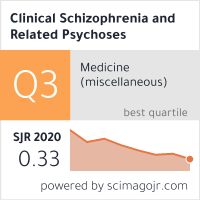404 Page not found!!
We weren't able to find this page. Here are some other open options you might take up!!About Us
The vision of the exciting new peer-reviewed quarterly publication Clinical Schizophrenia & Related Psychoses (CS) is to provide psychiatrists and other healthcare professionals with the latest research and advances in the diagnosis and treatment of schizophrenia and related psychoses. CS is a practice-oriented publication focused exclusively on the newest research findings, guidelines, treatment protocols, and clinical trials relevant to patient care.
Distributed free to the 23,642 highest U.S. prescribers of antipsychotic drug therapies, advertising in CS is limited to 6 to 8 ads per issue, providing maximum exposure for our select sponsors.
Editorial Mission
CS presents peer-reviewed original research and analysis that deals exclusively with the treatment of schizophrenia and related psychoses and is directly relevant to patient care through:
- Unique, disease-specific focus -& CS is the only clinical publication dedicated entirely to the latest research and advances in the diagnosis and treatment of schizophrenia and related psychoses.
- Clinically-driven content - Each quarterly issue provides practice-oriented original research results, case reports, comprehensive reviews, current treatment protocols, drug therapy updates, and clinical trial news, as well as meeting highlights from major conferences.
- Peer-reviewed credibility - Our distinguished Editorial Board is comprised of prominent schizophrenia researchers and clinicians from around the world.
- Exceptional 20/80 ad-to-edit ratio - Delivers maximum editorial coverage for our readers and maximum exposure for our select sponsors.
| Author Submissions: | For Reviewers: |
 |
 |
For any questions concerning our online manuscript system, contact: Karen Horn
CS is indexed in Medline/PubMed/IndexMedicus, Scopus, and EMBASE.
For additional information please contact us at: More Information









